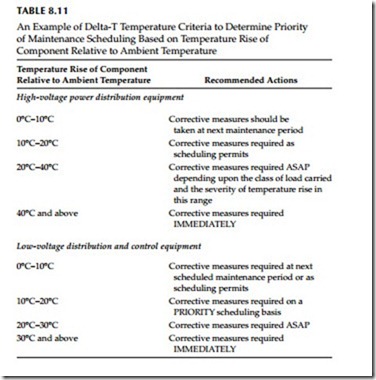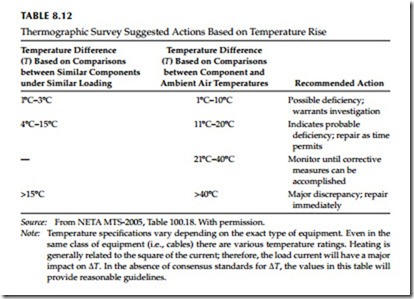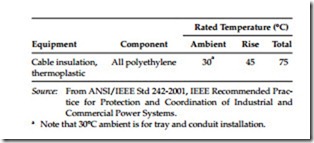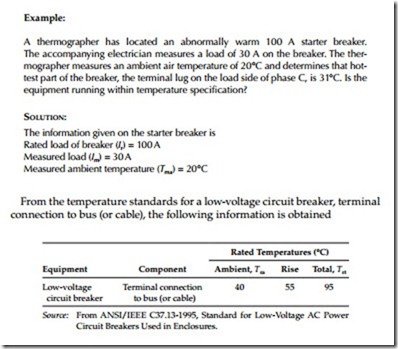Conducting an IR Thermographic Inspection
When an IR inspection is conducted, it is recommended to follow the current path, and it should be done under normal operating conditions—the heavier the loading the better an indication of the hot spots. During these surveys, it is obvious that the IR scanner detects temperature differences. A hot spot detected in an electrical equipment can be caused not only by excessive tem- perature due to faulty equipment (excessive resistance) but also may come about due to reflections, solar gain, normal loading, emissivity variations, and eddy current inductive heating. The person conducting IR scanning sur- veys should be familiar and be aware of these factors in order to identify a true hot spot. Also, additional factors such as wind, rain, snow, and strong magnetic fields can affect the IR survey results when conducting an IR scan of outdoor substations and switchyards.
After the IR survey is completed, the appraisal of the IR scan data is normally evaluated to assess whether the equipment surveyed is working properly or whether it has problem areas due to overheating. Over the years, different appraisal systems and techniques have evolved which maintenance personnel have used to determine priority of maintenance and repair actions. These are discussed next and have been summarized from a paper* presented at the National Electrical Testing Association (NETA) Annual Conference.
Delta-T Temperature Rating Systems
For years, IR thermographers have used delta-T temperature ratings to assess the severity of overheating electrical components. These tables are commonly broken into three or four severity categories that indicate repair priorities: the larger the temperature rise above a similar component or ambient tem- perature, the greater potential for failure. There are a wide variety of delta-T charts versus severity/repair urgency charts commonly used by thermogra- phers. Table 8.11 shows a delta-T temperature rating chart commonly used
in the electrical industry whereas Table 8.12 shows the delta-T criteria used by the NETA and similar criteria given in Section 21.17.5.6 of NFPA 70B, “Electrical equipment maintenance.”
On the plus side, such delta-T ratings have worked quite well in the field. They do indicate some relative degree of severity that enable repairs to be prioritized. On the negative side, there are a great number of temperature classifications and none of them are traceable to nationally recognized stan- dards for electrical equipment. This lack of traceability has been questioned in some industries, such as in the highly regulated nuclear power industry. The other major shortcoming of using delta-T classification systems is that they do not account for the actual load and ambient temperature upon the equipment at the time of the IR inspection. For example, an overheating cable under 70% load would be assigned the same severity rating if it was under a 10% load. Ideally, load and ambient temperature differences should be accounted for in a temperature rating system for determining accurate repair priorities.
Standards-Based Temperature Rating System
In the United States, there are over 26 organizations that publish temperature standards for electrical equipment. However, ANSI, IEEE, and NEMA are particularly well known and referenced. The standards published by these organizations on various electrical equipment contain temperature data which consists of the standard ambient temperature, the maximum tempera- ture rise allowed above the ambient, and the total allowed temperature, which is the sum of the ambient and the maximum temperature rise allowed. A typical electrical equipment standard might be expressed as follows:
The key formula: Mostly all temperature standards specify the standard ambient temperature and they assume that the circuit is under 100% load. However, electrical equipment is often run in a different ambient temperature and is rarely at 100% of rated load. So, for these standards to be meaningful,
Using the formula: First, we need to determine the temperature standards applicable to the equipment we are inspecting. We also need to know the maximum rated current for the equipment we are inspecting. Then, we need to measure the ambient air temperature and the actual load on the equipment. When we enter these numbers into the formula, we end up with the total cor- rected temperature (Ttc). This number (Ttc) is the corrected maximum allow- able temperature for this equipment and has been adjusted for the measured ambient temperature and down-rated for the measured load. The thermog- rapher then compares his/her measured equipment temperature to this total corrected temperature. If the measured temperature is greater than the Ttc, the equipment temperature is over the specification. If it is less than the Ttc, the equipment temperature is within the specification. While this formula and procedure may look formidable, it is easily run on a simple computer. You only need to know the temperature standards, the ambient temperature, and the rated and measured loads. Of course, the thermographer needs to know how to accurately measure the temperature of the equipment so that it can be compared to the total corrected temperature (Ttc). Below is an example of using this method.
We compare our measured temperature of 31°C to the Ttc of 24.95 and find that the heated terminal is 6.05°C above the Ttc specification which was cor- rected for measured ambient temperature and load.
Therefore, this example illustrates that there is a problem with this breaker and this problem will get worse as the load or the ambient temperature increases on the 100 A starter breaker.
Comparing the rating systems: Assuming that the temperatures of other two phases of this breaker were at ambient temperature, you will note that the Delta-T method of rating this potential problem would give you a tempera- ture difference of 31 − 20 = 11°C. In most Delta-T classifications, this would warrant a low-to-moderate severity rating. The standards-based system and formula has determined that the equipment is over specification. In compar- ing the two rating systems to many similar problems, we find that that the standards-based system is almost always more conservative than the Delta-T system. In other words, the standards-based system will almost identify a problem before the Delta-T system will.




